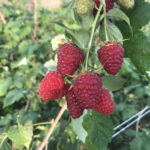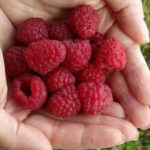Enrosadir raspberry variety
We did not have time to get to our sites Driscoll Maravilla, it was the turn of her sister - Margarita. And last year our market was excited by the appearance of a new remontant variety, very interesting and promising. And what is important, not just a remontant, but a real tutumer - a bright Italian woman named Enrosadir. For example, the Poles, since 2015, have been actively planting their tunnels with this European novelty. And Spanish farmers are hastily looking for new areas for planting it. We are not lagging behind, already preparing places on our sites. Moreover, some lucky ones were already harvesting their first harvest in the fall. But what surprises this raspberry will present to us and is it worthy of such increased attention - more on this in our article below.
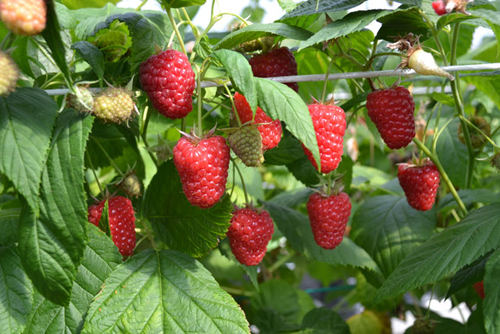
History of creation
The novelty was received in Favera (Trentino region, Italy) in 2004, in the Vivai Molari nursery, headed by Gilberto Molari. The breeder was Aldo Telch, the creator of the Vajolet Plus and Lagorai Plus varieties. During the breeding of our heroine, T44L04 "Lagorai" (acting as a female plant) and numbered T35L04 (acting as a male) were re-pollinated.
After sowing the seeds, seedlings were obtained, which subsequently, since 2008, multiplied by asexual root cuttings. It was found that varietal traits are stable, and distinctive characteristics are transmitted unchanged during asexual reproduction. The application for registration of the novelty was submitted in 2013. Enrosadir is a protected, patented variety. Patents US20140317798P1, 10.2014, USPP28138P3, 06.2017 All rights to raspberries belong to: AZ. AGR. Molari & Gatti Di Molari Gilberto.
Description
Enrosadira is an early maturing Italian remontant variety. And the novelty is not just an early remontant - it is a full-fledged totimer! At the international exhibition MACFRUT, held in Rimini, Italy, our heroine received a gold medal in the category: "Best variety".
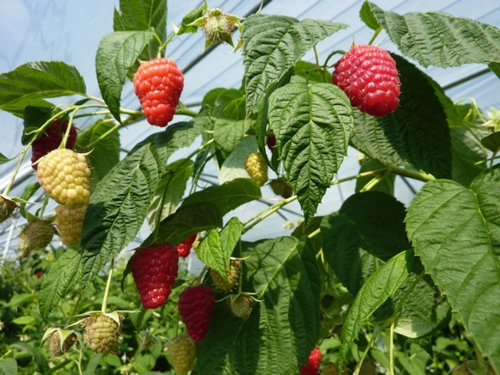
On the shoots of the current year, the harvest begins to ripen in mid-July. Ripening dates may vary depending on the region of cultivation. In the Middle Lane, our heroine begins to bear fruit in August. But already on last year's shoots in the south, it has been singing since the beginning of June, along with the early varieties of summer raspberries. The period of autumn fruiting is somewhat extended and is 60 - 70 days. In the tunnels to the south, the plant produces its entire harvest in September; in the open field and in more northern areas, it bears fruit until early November. Like another Maravilla tutu, which has already become legendary, our heroine gives most of the harvest on the shoots of last year, at the beginning of summer. On the shoots of the current year, the yield is 25-30% less.
Shoots are strong, vigorous, tall, upright. Their average growth in the season is 175 cm, but they can reach 2-2.5 meters in height with good agricultural technology, and especially when grown in greenhouses. Young shoots are juicy green in color, they lack anthocyanin coloration. Shoots of the second year after ripening turn light brown or grayish-orange. Stems are slightly covered with thorns. The spines are short, with a thick base, straight, purple in color. Raspberry laterals are strong, resilient, medium and short in length, well branched.
The variety is characterized by a very powerful and branched root system. Thanks to this, Enrosadira has good drought tolerance and high responsiveness to root fertilization. And also the introduction of organic matter into the soil. The leaves are green, medium in size, 10-12 cm long and 6-8 cm wide. They are oval in shape with a rounded base and a sharp nose, strongly corrugated, sharply serrated at the edges. The flowers are medium in size, 1 cm long, white.
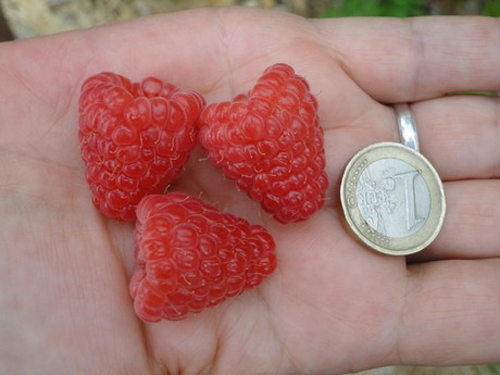
The berries are beautiful, bright, light red in color with a glossy sheen, slightly pubescent. Lighter than the fruits of the legendary Regiment. Drupes are one-dimensional, tightly linked to each other. They contain a small amount of small seeds. The berries are easily removed during collection, do not crumble or flow.Raspberry fruits are large and very large, fleshy, even and uniform, weighing 6-8 grams, but can be poured up to 10-12 grams. Berries have an average length of 3 cm, and a width of 1.9-2.0 cm. They are wide, elongated-conical in shape. The berries are strong and firm. The skin is thin, elastic, resistant to mechanical damage. The fruits have high commercial characteristics.
The berries are very tasty, sweet, one might even say uniquely tasty. The pulp is juicy, with a rich, thick raspberry aroma. When the berries are sold by Italian farmers, they get a few euros more for the fruits of Enrosadira. And large farmers in Spain, after test plantings, hastily allocate up to 90% of the area allotted for remontants, specifically for this raspberry.
The variety has a very high shelf life and transportability, the berries do not rot even without refrigeration. It is especially important during storage to maintain the desired level of humidity and temperature. With proper cooling, the fruits retain their high commercial characteristics for 10 - 11 days. Originators advise storage at + 3 ° C in regularly ventilated rooms.
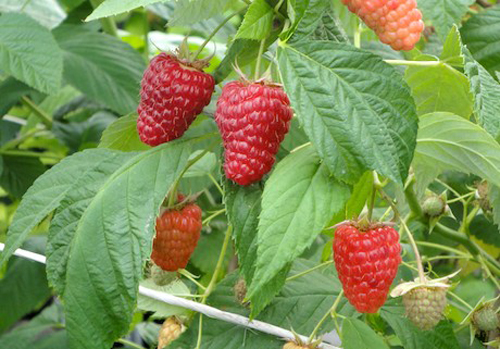
Enrosadira is characterized by its versatile fruit. They are perfect for both personal consumption and successful sales in the wholesale and retail markets of fresh berries. They are widely used in cooking, decorating and filling desserts, baking and making cocktails. Suitable for drying, freezing and all types of processing.
The variety is highly resistant to major diseases and pests of raspberries. In particular, to fading shoots and raspberry rust, as well as late blight root rot. Resistant to didimella (purple spot) damage. Possesses normal, tested frost resistance up to -25 ° С. Better than the repairmen Kwanza and Eric.
Enrosadir has a very high and stable yield. It already shows indicators at the level of a recognized benchmark - Shelves, up to 25 t / ha. But this is clearly not the limit. Another significant point is that our heroine gives up to 90% of the fruits of the first class. Due to the early ripening period, it is suitable for regions with an early onset of autumn cold weather. But it will be desirable to use it as a remontant variety with exclusively autumn fruiting. This is because our heroine has an extended period of fruiting. And harvesting on last year's shoots pushes back autumn fruiting by an average of 10 days. Well, however, here everyone must decide for himself, personally pick up the "keys" to the variety. What is great for some gardeners, it does not work for others. And vice versa. You need to plant and try it yourself.
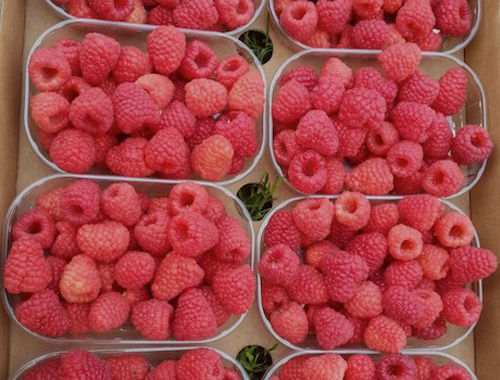
Gilberto Molari, owner of the Vivai Molari nursery, said that they achieved three harvests per plant per year. Of course, when grown in tunnels. He spied this idea in Spain, which has a hotter climate. And the problem arose of choosing a variety of raspberries for such purposes. And subsequently, the appearance of Enrosadira decided this issue.
An interesting report for 2016 (second year of planting) from an experiment commonly known as the Malinowe Factory project. It is the best and most famous collection of different varieties of raspberries in Europe, grown in tunnels for scientific purposes. Cultivation is carried out with the aim of testing growing technologies, optimizing protection and feeding systems, obtaining maximum yields and the best quality berries.
The project was founded in 2015 in Poland. The plantation was planted in June / July. We used seedlings in vitro with a closed root system, in pots and multi-plates (cassettes). 13 remontants were evaluated, including our heroine. Planting pattern - 3.0 meters between rows and 40 cm between plants in a row. The number of plants planted per hectare is 8300 pieces.
Please note that these are indicators for 2016, the plantings are young, they are only 2 years old.
| Variety name | Harvest from 1 bush, kg | Harvest per hectare, t | The beginning of fruiting | Mid / end fruiting | Weight of 100 berries, g |
| Imara | 3,14 | 26,1 | 19.07 | 24.08/24.10 | 534,0 |
| Erica | 3,08 | 25,6 | 13.07 | 06.09/24.10 | 536,7 |
| Polka | 3,02 | 25,1 | 13.07 | 18.08/24.10 | 498,8 |
| Enrosadira | 2,82 | 23,4 | 25.07 | 24.07/24.10 | 548,1 |
In the general table in terms of yield, our heroine is in 6th place out of 13, ahead of the varieties Kweli (25.1 tons) and Paris (24.8 tons). It is immediately followed by Kwanza with the same yield - 23.4 tons. The last on the list are Versailles (16.3 tons) and Deauville (13.0 tons) varieties. In terms of large fruit size, Enrosadir is in 5th place in 2015, and in 2016 it moved to 6th.
With a planting scheme of 0.4 meters between raspberry bushes in a row and a row spacing of 3.0 meters, the yield of our heroine in the year of planting was 5.3 tons. On average 0.64 kg per plant. Its neighbors for this indicator were: Polka 6.2 tons, Paris 5.2 tons, Versailles 4.2 tons.The leaders in the list in terms of productivity were: Imara 10.3 tons, Kweli 9.6 tons, Erica 9.1 tons. (According to Dr. Paweł Krawiec, Uniwersytet Przyrodniczy w Lublinie / Horti Team).
Strengths
- A real workhorse, it has a high yield among remontants. The productivity of our heroine is at the Shelf level, and she has the potential to increase this indicator.
- High percentage of first grade fruits, up to 90%. Excellent appearance of the harvest, the berries are beautiful, even, one-dimensional, large and very large.
- High indicators of keeping quality and transportability. When refrigerated, the fruits can be stored for up to 10-11 days without loss of marketability.
- Resistant to major diseases and pests of raspberries.
- The versatility of the fruit.
- Early ripening, the ability to give two crops per year. Our heroine is a full-fledged tutor. And in the conditions of the south of Europe, even 3 crops per year are obtained from it!
- Exceptional indicators of taste, fruits are very sweet and aromatic. European farmers get more money for this variety than for others.
- Normal indicators of frost resistance, heat resistance and drought resistance.
- Good vigor, strong shoots, slightly spiny. Good multiplication factor.
- The variety, although young, is already titled, which received a gold medal at the international exhibition in Rimini.
- Enrosadira can be successfully cultivated both in greenhouses (foil, polycarbonate greenhouses, and tunnels) and in the open.
- Raspberries are great for both hobbyist and industrial cultivation.
Weak sides
- The berries darken slightly when cooled.
- With the onset of early cold weather, the plant may not have time to give up part of the harvest.
- The variety is young, requires a diverse study when grown throughout the country.
- Due to the high cost and demand for Enrosadir's seedlings in the market, there is a high risk of buying a re-grading from dishonest sellers. It is necessary to order raspberry seedlings only from trusted suppliers with an already established positive reputation in the market.
Author: Maxim Zarechny.




